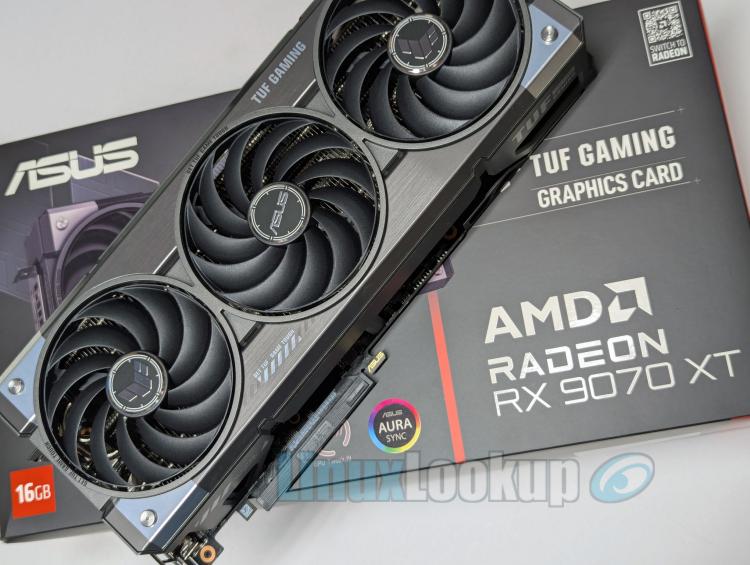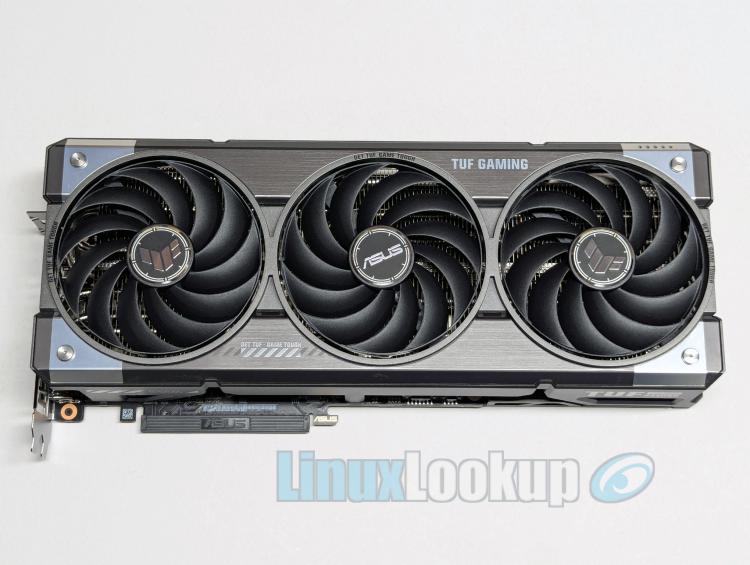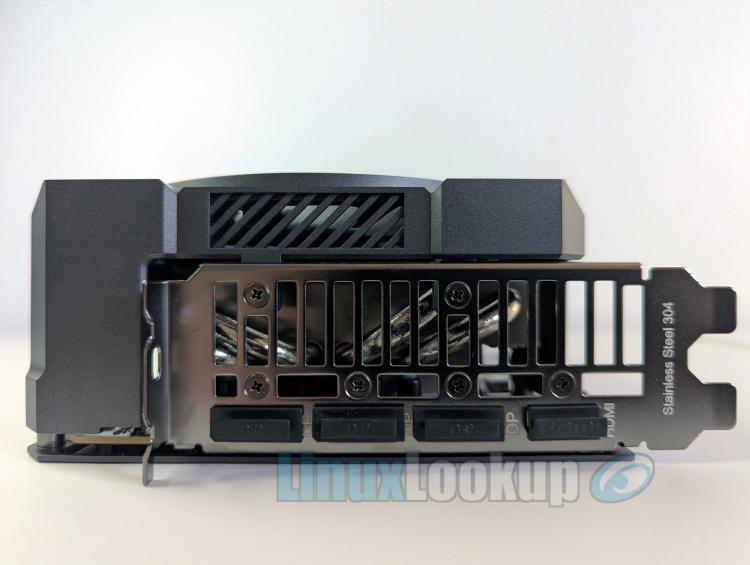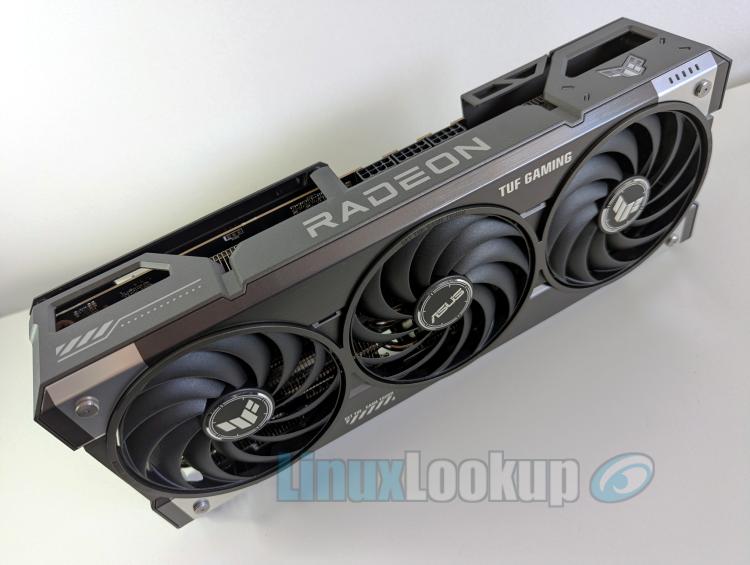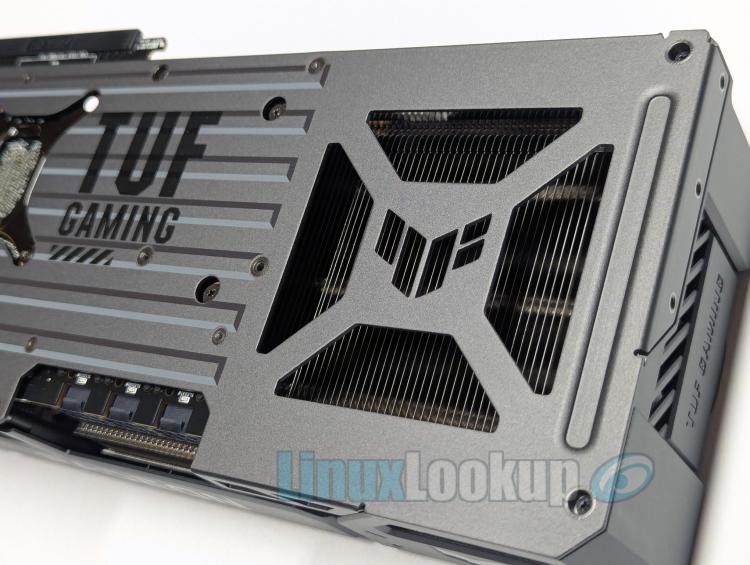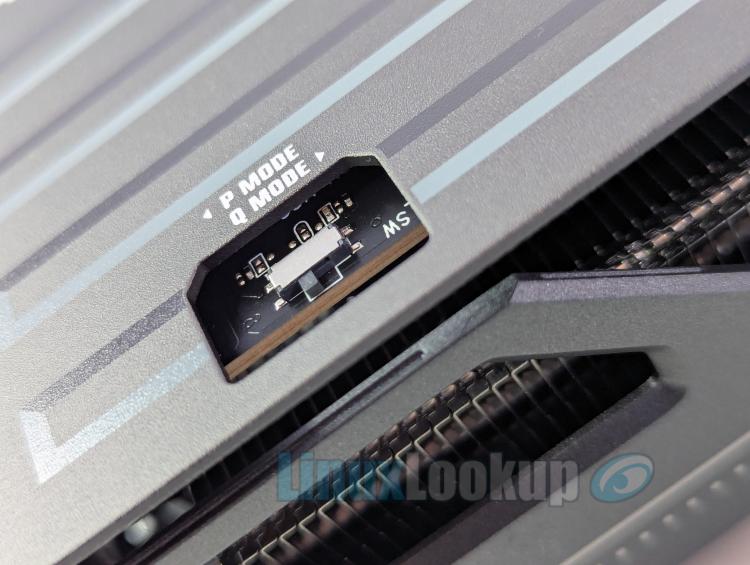ASUS TUF Gaming Radeon RX 9070 XT OC Review
The ASUS TUF Gaming Radeon RX 9070 XT OC Edition embodies what TUF does best, combining rugged durability, advanced cooling, and a confident factory overclock that squeezes more out of AMD's new RDNA4 architecture the moment you fire it up.
In this GPU review, we'll highlight the stand-out features and provide Linux performance benchmarks.
AMD's Radeon RX 9070 launched on March 6, 2025, marking a major milestone for the upper-mid-range GPU market and introducing the first graphics cards built on the new RDNA4 architecture.
The debut lineup included two models differentiated by performance and price: the Radeon RX 9070, priced at $549 MSRP, and the more powerful Radeon RX 9070 XT at $599 MSRP.
Leading the pair, the RX 9070 XT sets itself apart as the stronger option, featuring a fully unlocked core configuration and notably higher clock speeds. It draws more power than its sibling but delivers a clear performance advantage.
As is typical for AMD launches, both cards were released exclusively through board partners (AIBs). Among them, ASUS offered two standout custom designs: the Prime Radeon RX 9070 XT OC (MSRP $599.99) and the TUF Gaming Radeon RX 9070 XT OC Edition (MSRP $799.99).
The Prime model sits closer to AMD's reference pricing, offering clean aesthetics, efficient cooling, and a modest factory overclock. It is a strong choice for builders who want performance that matches the RX 9070 XT's mainstream positioning. The TUF Gaming Edition, in contrast, carries a $200 premium but justifies it with a larger and more capable cooler, greater thermal headroom, and a rugged design aimed at enthusiasts who value low noise, higher sustained boost clocks, and long-term reliability.
Both cards represent meaningful improvements over AMD's reference specifications, giving buyers the flexibility to choose between balanced value and a more performance focused, overbuilt option.
Below are the key specifications of the RX 9070 XT reference card alongside the two ASUS models for comparison. Highlighted is the TUF Gaming Radeon RX 9070 XT OC Edition featured in this review.
| RX 9070 XT | Prime RX 9070 XT | TUF RX 9070 XT | |
| GPU Die | Navi 48 | Navi 48 | Navi 48 |
| Architecture | RDNA4 | RDNA4 | RDNA4 |
| Compute Units | 64 | 64 | 64 |
| Ray Accelerators | 64 | 64 | 64 |
| Game Frequency | 2400MHz | Up to 2480MHz | Up to 2540MHz |
| Boost Frequency | Up to 2970MHz | Up to 3030MHz | Up to 3080MHz |
| Infinity Cache | 64MB | 64MB | 64MB |
| Memory | 16GB GDDR6 | 16GB GDDR6 | 16GB GDDR6 |
| Memory Speed | Up to 20Gbps | Up to 20Gbps | Up to 20Gbps |
| Memory Bus | 256-Bit | 256-Bit | 256-Bit |
| Memory Bandwidth | 640GB/s | 640GB/s | 640GB/s |
| Power Connectors | 2 x 8-pin PCIe | 3 x 8-pin PCIe | 3 x 8-pin PCIe |
| Board Power | 304W | ~304W - 315W | ~315W - 330W |
| Recommended PSU | 750W | 750W | 850W |
Regardless of the brand you choose, every RX 9070 XT is built on AMD's RDNA4 architecture. This new design represents a major leap forward in efficiency, AI integration, and visual fidelity. At its core is FidelityFX Super Resolution 4 (FSR4), an AI-powered upscaling technology that uses dedicated AI accelerators and 8-bit floating-point (FP8) precision to deliver sharper visuals and improved temporal stability. The result is a smoother, cleaner image that finally puts AMD on level footing with NVIDIA's DLSS.
Ray tracing performance also sees a significant boost thanks to third generation Ray Tracing Accelerators, which offer higher throughput per compute unit than RDNA3 and make ray traced titles far more playable. Complementing this are new AI accelerators that not only enhance FSR4 but also pave the way for future features like AI based ray regeneration. AMD has further refined its Fluid Motion Frames (AFMF) 2.1 frame generation technology, reducing ghosting and delivering smoother performance across a wider range of titles.
Rounding out the upgrades, RDNA4's Advanced Media Engine provides more efficient AV1 encode and decode support, while expanded Vulkan API compatibility ensures developers can fully leverage the hardware on both Windows and Linux. With strong open source driver support through Mesa/RADV and rapid integration of new Vulkan extensions, Linux users now enjoy near feature parity with Windows. Altogether, RDNA4 strikes a smart balance between innovation and refinement, setting a strong foundation for AMD's next generation of creator and gaming focused GPUs.
Next, let's shift focus back to what ASUS is doing, and the features exclusive to their TUF Gaming Radeon RX 9070 XT OC Edition.
As I always do, I want to take a moment to acknowledge AMD for its ongoing commitment to open source software. It's also genuinely exciting to see Linux listed before Windows on retail packaging, even if it's likely just in alphabetical order.
AMD's board partners, on the other hand, have yet to formalize similar commitments. In the case of ASUS, their GPU Tweak III, Armoury Crate & Aura Creator software isn't compatible with Linux. However, there are several open source software alternatives available for AMD graphics cards, offering comparable flexibility for tailoring your system setup to personal preference.
The retail package contents are fairly straightforward, including a quick start manual, certificate of reliability, and thank you card, along with TUF branded extras such as a case magnet, cable strap, and GPU support bracket.
Aesthetically, the ASUS TUF Gaming Radeon RX 9070 XT OC Edition lives up to its "tough" name. While the front shroud is constructed entirely from plastic (aside from the four corner rivets) it convincingly mimics a brushed metal finish, presenting a sharp two tone black and grey design with minimal branding or embellishment.
Physically, this graphics card measures 330mm in length, 140mm in width, and 62.5mm in height, with a 3.125 slot profile for installation, and includes an anti‑sag bracket. The three 95mm Axial-tech fans use dual ball bearings for improved durability and longevity. To ensure smooth, optimized airflow, the two outer fans rotate counterclockwise, a design choice that helps reduce turbulence and enhance overall cooling efficiency.
The top side, along the outer edge, features ARGB lighting in the shape of the distinctive TUF logo.
On the backside, an aluminum backplate with chunky recessed lines, silkscreen text, and caution tape patterns complements the card's bold, industrial aesthetic.
This is where things get interesting. ASUS has taken thermal efficiency to the next level, and not just with the large vented cutout, but with what's hidden between the backplate and shroud. The card uses a non-conductive thermal pad that remains solid at room temperature but liquefies when heated. This phase change allows it to completely fill microscopic gaps between the GPU die and heatsink, resulting in superior thermal transfer compared to traditional paste or standard pads.
Adding to that, ASUS employs an exclusive manufacturing process that polishes the heat spreader to an exceptionally smooth finish, improving contact with the GPU die by up to 5% over conventional designs. The PCB also receives a conformal coating, a thin protective film that shields sensitive components from moisture, dust, and corrosion, enhancing long term durability.
It's a reminder that true engineering often hides beneath the surface, what you don't see is what sets it apart.
ASUS does not list an official typical board power (TBP) for this card, but based on the recommended minimum 850W PSU, it is reasonable to estimate around 330W, delivered through three 8‑pin PCIe connectors.
To the left of the power connectors is the dual BIOS toggle switch, which lets users quickly switch between the default performance (P) mode and the silent, quiet (Q) mode.
For display connectivity there is one HDMI 2.1b port and three DisplayPort 2.1a ports.
The ASUS TUF Gaming Radeon RX 9070 XT OC Edition comes factory overclocked, giving you a boost straight out of the box. With +120 MHz on the Game Clock, +90 MHz on the Boost Clock, and an extra +26 W TBP, it delivers a small but noticeable increase in gaming performance over AMD's reference design, meaning smoother frame rates and slightly higher headroom in demanding Linux gaming titles.
Performance
Linux gaming performance benchmarks are conducted using a mix of modern and older titles available through Steam. Since many games do not include native Linux support, testing relies on Steam Play (Proton) or a community maintained Proton build to ensure proper compatibility.
AMD's official Radeon driver version 24.30.4 introduced launch day support for select Linux distributions. Depending on your setup, you may choose to run the latest AMD proprietary driver or use Mesa 25.0.0 from a rolling-release distribution, the Kisak-Mesa (Fresh) PPA, or the bleeding-edge Mesa packages from the Oibaf-Latest PPA.
FSR4 on Linux is usable today, but the ecosystem is still maturing. Valve's official Proton builds (as of late 2025) have not yet integrated complete FP8 support, so enabling FSR4 currently requires one of two alternative methods, each involving a bit of setup outside the scope of this hardware review. In short, you'll need a modern Linux distribution with a recent kernel, an updated Mesa driver (version 25.2 or newer), and a community maintained Proton build such as Proton-GE or Proton-CachyOS. The other option is the OptiScaler method, though its configuration process is more involved. For Steam, I'd recommend GE-Proton10-25 with the PROTON_FSR4_UPGRADE=1 launch option.
Ubuntu was used to establish a minimal performance baseline, results will differ based on system specs, kernel level, graphics driver, Proton version and launch options.
Test System
- Processor: AMD Ryzen 7 9700X
- Motherboard: ASUS ROG Strix X870E-E Gaming WiFi
- Memory: 64GB DDR5-6000
- Distribution: Ubuntu 25.10 Desktop
- Linux Kernel: 6.17.0-6-generic
- Graphics Driver: Mesa 25.2.7
- Proton Version: GE-Proton10-25
- Resizable BAR: Enabled
All games are benchmarked at High settings with Ray Tracing (RT), frame generation, and FidelityFX Super Resolution (FSR) turned off, highlighting pure rasterization performance. Any tests run with these features enabled are clearly indicated in the results as (FSR/RT).
| Cyberpunk 2077 | ||||
| Presets: High. Ray Tracing, FSR, FrameGen: Off. VKD3D (DX12) | ||||
| Resolution | 1080P | 1440P | 4K | 4K (FSR/RT) |
| Average FPS | 188.3 | 142.1 | 74.1 | 107.7 |
| 1% Low FPS | 106.5 | 108.7 | 50.6 | 61.7 |
| 0.1% Low FPS | 69.7 | 92.8 | 26.8 | 36.2 |
| Average Power Draw | 324W | 328W | 328W | 317W |
| Average GPU Temperature | 52C | 51C | 49C | 49C |
| Warhammer 40K Space Marine 2 | ||||
| Presets: High. Ray Tracing, FSR, FrameGen: Off. VKD3D (DX12) | ||||
| Resolution | 1080P | 1440P | 4K | 4K (FSR/RT) |
| Average FPS | 112.2 | 110.5 | 70.8 | 187.9 |
| 1% Low FPS | 62.2 | 63.4 | 58.6 | 97.3 |
| 0.1% Low FPS | 37.1 | 44.3 | 53.9 | 57.2 |
| Average Power Draw | 123W | 259W | 329W | 289W |
| Average GPU Temperature | 50C | 49C | 51C | 51C |
| Counter-Strike 2 | |||
| Presets: High. Ray Tracing, FSR, FrameGen: Off. Vulkan (Linux Native) | |||
| Resolution | 1080P | 1440P | 4K |
| Average FPS | 494.4 | 390.2 | 201.3 |
| 1% Low FPS | 147.7 | 151.2 | 115.9 |
| 0.1% Low FPS | 73.6 | 71.1 | 64.6 |
| Average Power Draw | 184W | 276W | 281W |
| Average GPU Temperature | 50C | 51C | 50C |
| Red Dead Redemption 2 | |||
| Presets: High. Ray Tracing, FSR, FrameGen: Off. VKD3D (DX12) | |||
| Resolution | 1080P | 1440P | 4K |
| Average FPS | 120.6 | 119.4 | 93.9 |
| 1% Low FPS | 82.6 | 77.6 | 68.2 |
| 0.1% Low FPS | 36.1 | 35.3 | 56.3 |
| Average Power Draw | 139W | 218W | 294W |
| Average GPU Temperature | 50C | 50C | 51C |
| Marvel Rivals | |||
| Presets: High. Ray Tracing, FSR, FrameGen: Off. VKD3D (DX12) | |||
| Resolution | 1080P | 1440P | 4K |
| Average FPS | 139.5 | 114.7 | 91.7 |
| 1% Low FPS | 90.7 | 81.4 | 71.5 |
| 0.1% Low FPS | 31.9 | 34.5 | 36.4 |
| Average Power Draw | 263W | 304W | 320W |
| Average GPU Temperature | 51C | 49C | 50C |
Gallery
Conclusion
The Good - Pros- Excellent 1440p Linux gaming performance
- Ray tracing performance improved significantly
- Good thermals, acoustics & power efficiency
- Very well constructed, but heavy
- 16GB of GDDR6 VRAM
- ASUS uses IST certification of components
- ASUS exclusive cooling features
- FSR4 delivers, but expect tinkering on Linux
The Bad - Cons
- Premium price is fair, but fluctuates above MSRP
The Ugly - Issues
- FSR4 had early implementation issues on Linux
The Verdict - Opinion
The AMD Radeon RX 9070 XT lands as a compelling upper-mid-range card that pushes confidently toward high-end performance, delivering excellent rasterization results and a meaningful architectural leap with RDNA4. It excels at 1440p and remains capable at 4K while benefiting from improved efficiency. Ray tracing still lags behind NVIDIA, but the generational gains are substantial, and FSR4's AI-driven upscaling puts AMD in a far stronger position moving forward. ASUS's TUF Gaming Radeon RX 9070 XT OC Edition builds on that foundation with a beefier cooler, tougher materials, and a healthy factory overclock that adds extra headroom without compromising acoustics.
